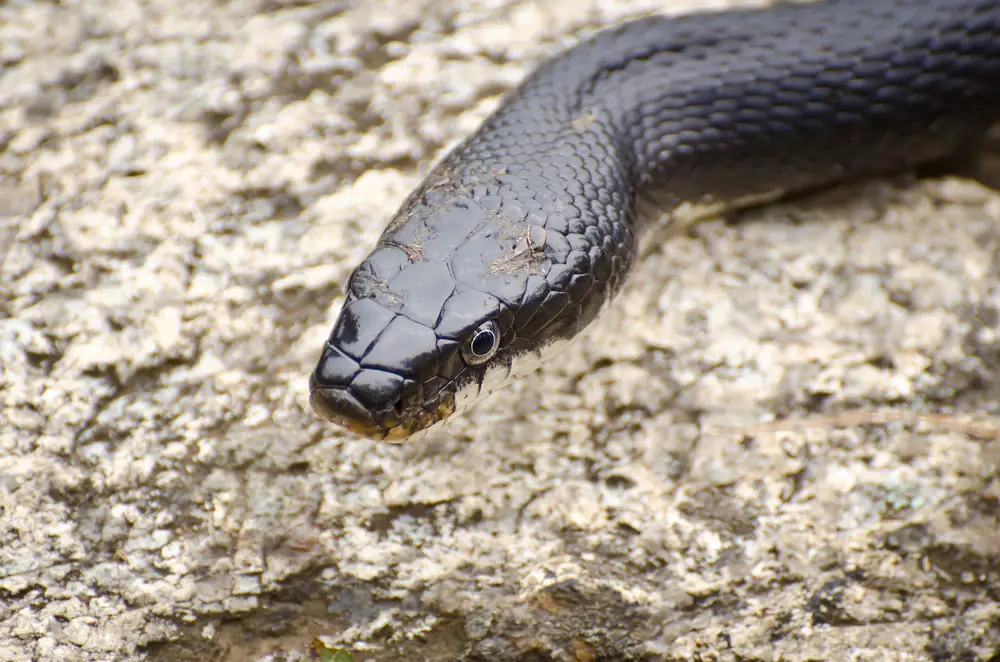Black Rat Snakes eat a wide variety of prey in the wild. They do have a preference for rodents in particular, though, making them helpful for pest control…
Last updated on April 7th, 2023 at 08:05 am
As predators, black rat snakes play an important role in controlling pest populations. Their diet primarily consists of small rodents, such as mice and rats, though they are also known to consume lizards, frogs, birds, and bird eggs. This adaptability in diet makes them a beneficial group of predator species in many habitats.
Black Rat Snakes are black populations that belong to three species: the Eastern Rat Snake (Pantherophis alleghaniensis), the Gray Rat Snake (Pantherophis spiloides), and the Western Rat Snake (Pantherophis obsoletus).
These species all have similar habits, and their most commonly recorded prey items in the wild include:
- Nestling birds and their eggs
- Adult Woodpeckers, including the Red-cockaded Woodpecker
- Adult Jays, including Blue Jays
- Rats
- Mice
- Chipmunks
- Meadow Voles
- Deer Mice (Peromyscus species)
- Tree Frogs, including invasive Cuban Tree Frogs
- Golf balls. YES, golf balls have been found in their stomachs!
Most evidence suggests that their favoured prey items are rodents and birds. Notwithstanding, herpetologists agree that Rat Snakes are opportunistic predators when given the chance.
Do Rat Snakes Eat Copperheads?
With their dense musculature, Rat Snakes are strong constrictors that can blend in with the background at night, making them a formidable foe for prey.
But is it true that Rat Snakes tackle venomous prey, such as copperheads? While it might seem like an appealing survival technique for them, the answer is no. They specialize in eating smaller prey such as mice or birds, rather than Copperheads, despite how common this species is throughout much of their range.
Many species of snake specialize in just one or two types of prey, as a way of avoiding competition with other species. This is something called resource partitioning.
If Rat Snakes eat mainly rodents and birds rather than snakes like Copperheads, then they avoid competing with King Snakes and Milk Snakes who are specialist snake eaters.
At the same time, all but the largest Rat Snakes would want to avoid King Snakes altogether, not just because of competition, but because they might eat them. The last thing they would want to do is go after a type of prey that King Snakes might also be hunting.
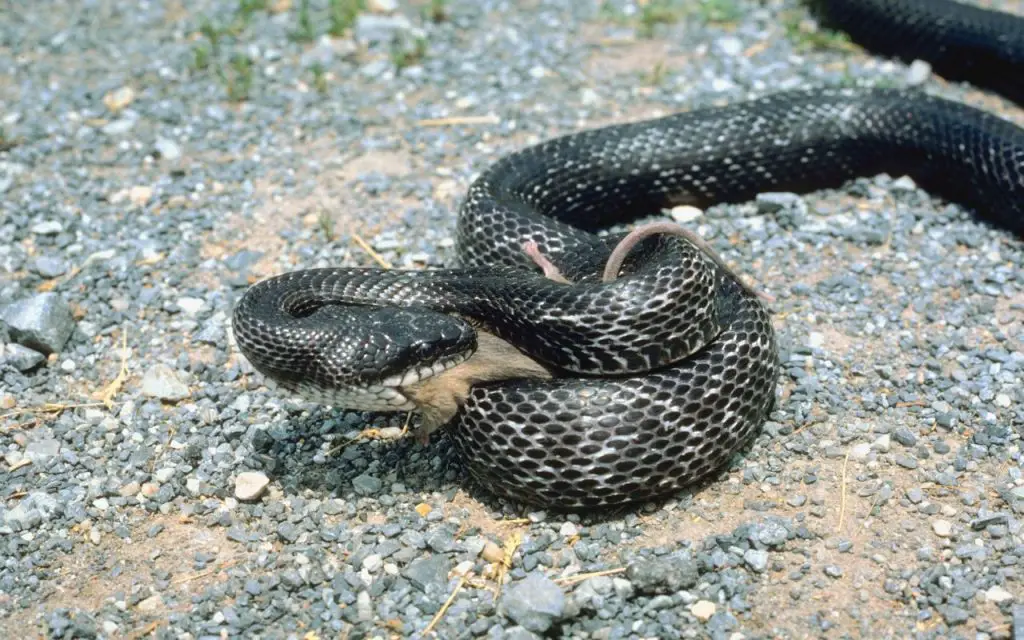
Are Black Rat Snakes Aggressive?
Black rat snakes, though rarely aggressive, should be respected. When feeling threatened, they will coil and strike repeatedly with their head. While these actions can be intimidating, it is important to remember that such reactions are a natural survival instinct.
Whether you come across a wild black rat snake or one in captivity, proper caution should always be taken to ensure the safety of both the snake and any humans involved.
Don’t forget that most of their strikes miss, and don’t really do much if they do get you. If a black Rat Snake strikes repeatedly at the wall of its enclosure, however, this can damage its rostrum (snout) and allow an infection such as stomatitis to set in.
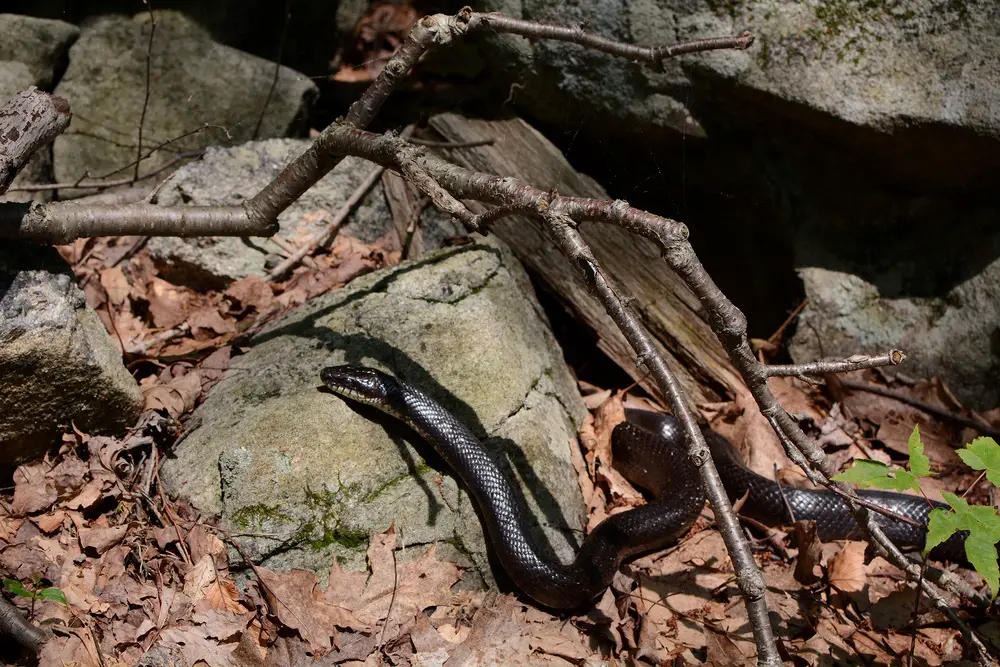
Black Rat Snake Bite
I’ve been bitten by many, many types of animal over the years. All-in-all, I’d say that bites from colubrid snakes like Rat Snakes are the least impressive.
At most, a black Rat Snake can manage a little scratch. It is nothing compared to the bite of a dog, turtle, or rat. They do a good threat display if harassed though, which can look intimidating.
Some Rat Snakes even do their best Rattlesnake impression when frightened, by hissing and rattling their tail against dry leaves. If you don’t back off, they’ll strike, and very occasionally bite.
Medically speaking, there’s zero risk of serious injury from a black Rat Snake bite. That said, you should still wash it well with soap and water. After all, the snake might have eaten a rat recently, which doesn’t sound particularly hygienic…
Are Black Snakes Good To Have Around?
Black rat snakes are essential in maintaining balance in our natural ecosystems. In addition, by consuming large amounts of rats, mice, and other pest animals, they are a key ally for farmers.
This can help save time, resources, and money that would otherwise be spent trapping or manually eliminating offending pests.
In addition to helping farmers control their pest problems without intervention, these beneficial snakes also engage in natural rodent population control as part of their normal hunting habits.
All the same, some people do get sad about the fact that these snakes eat chipmunks. I can understand this, because chipmunks are extremely cute.
It’s important to remember, however, that predators often pick off sick animals, which improves the health of the overall population. Therefore, black Rat Snakes are important to any rural community’s ecolosystem.

Black Rat Snake Size
Famous for their sleek, black bodies, black Rat Snakes are one of most commonly encountered snakes from New England, all the way to Iowa. Reaching an average size of 3.5 to 6 feet as adults, these powerful serpents can sometimes exceed 8 feet in length.
Overall, most black Rat Snakes that you’ll find in the wild will be around the 4ft mark, with some reaching 5ft. Animals over 6ft are rare, but do still occur. There are in fact several Rat Snakes around 7ft long in captivity (not including the ‘big fish’ stories, of course).
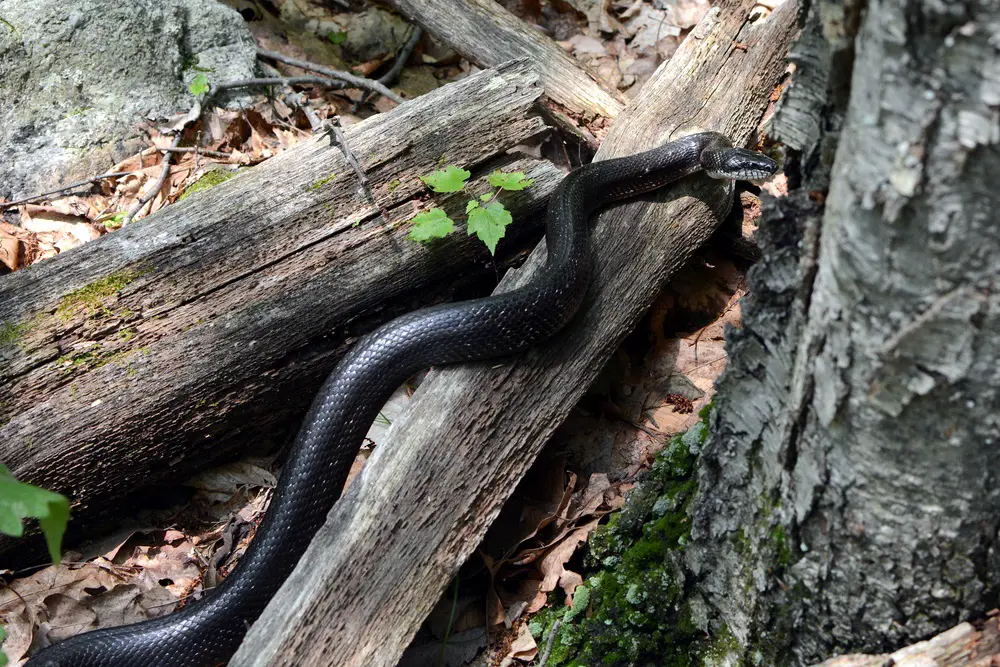
Are Black Rat Snakes Friendly?
Black rat snakes may be startling when encountered by humans, but they are a beneficial species that help regulate rodent populations.
In addition, these constrictors have a reputation for being docile and non-aggressive, making them a harmless snake species in residential areas. Often, they just sit still, or quietly try to move away when you approach.
While they can be friendly and inquisitive in captivity if given excellent husbandry, it is important to remember that they should always be respected in the wild.
Leaving black rat snakes peacefully in their natural habitat allows them to help maintain ecological balance and focus on their primary task of controlling rodents.
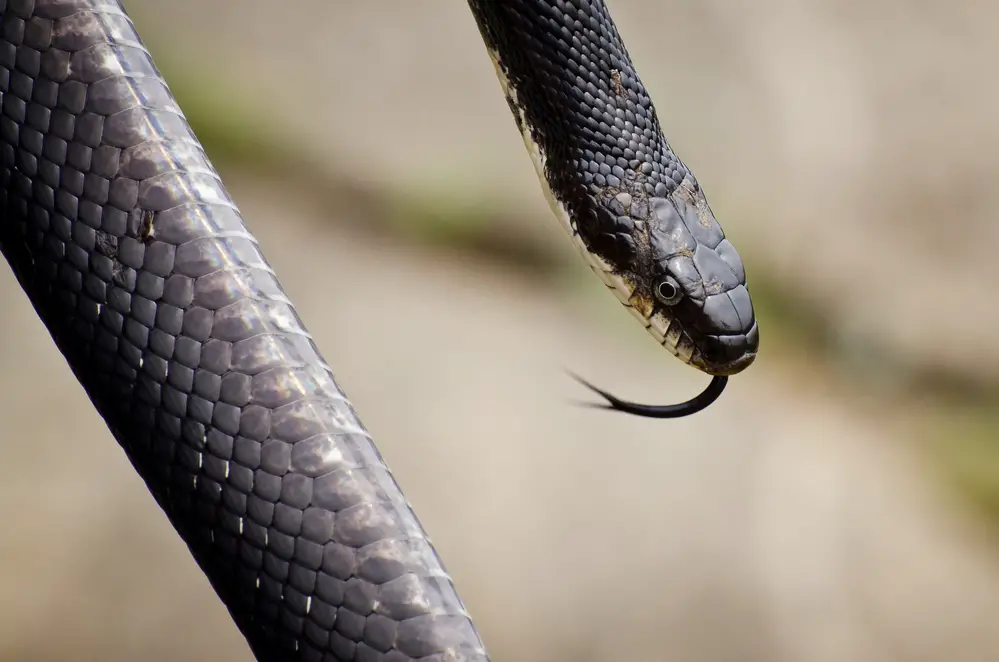
Do Black Snakes Eat Copperheads?
Here is where the confusion comes from: Some black snakes do eat Copperheads. However, those black snakes that eat Copperheads are not black Rat Snakes!
Specifically, two of the most commonly encountered black snakes, the Black Racer (Coluber constrictor) and Eastern Kingsnake (Lampropeltis getula), regularly consume copperheads. The Eastern Kingsnake in particular is a snake eating specialist (ophiophage).
Of the two, the Black Racer looks most like a black Rat Snake, and it is understandable that observers mistake it for one while it gulps down a poor Copperhead. They are very common, generalist hunters that will eat pretty much anything that moves.
What Can I Feed A Rat Snake?
Generally speaking, most rat snakes will happily consume rodents, birds and bird eggs, some lizards, frogs, and even voles. However, limiting how frequently you offer bird eggs is important as they contain more fat and less calcium than other food sources.
In captivity, it’s best to feed them jumbo mice, weaner rats, and chicks as a staple diet. Chicken eggs will be a welcome treat, but not necessary.
Personally, I’ve had three Eastern Rat Snakes over the years and they all did fine on a couple of jumbo mice a week or one weaner rat.
Feeding adult rodent prey slightly larger than the widest part of the snake’s body is commonly suggested to avoid digestion issues or intestinal blockage.
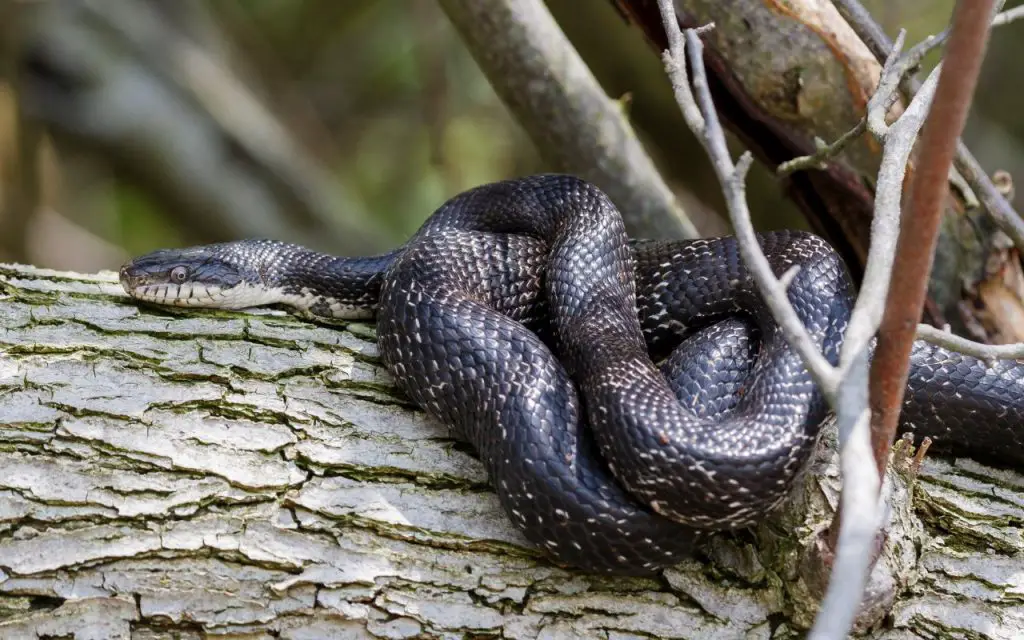
Black Rat Snake Maryland Poisonous
The black rat snake is a common sight in Maryland, and although these long snakes may startle people who come across them in the wild, their bites are harmless.
As non-venomous constrictors, they are perhaps most highly valued by farmers for their ability to eat rats, mice, and other pests.
It’s important to remember that black rat snakes can still be defensive when feeling threatened, so it’s wise to give these creatures space if you spot one.
Are Rat Snakes Good To Have Around The House?
Rat snakes can be good to have around the house as free pest control. Though their presence can initially be disconcerting, rat snakes are non-venomous and typically quite docile compared to other species.
This means they are an ideal creature to teach children about, helping them learn that not all snakes need to be feared. As such, rat snakes provide a beneficial service and don’t have to be seen as a nuisance if you find one in or around your home.

How Often Do Rat Snakes Eat?
On average, rat snakes should be given one meal every seven to ten days to maintain optimal health and well-being; any more often can cause digestive issues.
This amount ensures that they get enough energy while avoiding the risk of becoming overweight or unhealthy. Thouhg highly muscular, Rat Snakes are more slender than Pythons or Boas, for example.
They quickly become obese if overfed, leading to fattly liver disease and heart disease. Often, the first sign of this is a persistently bloated belly or uneven fat deposits along the flanks.
Black Rat Snake Habitat
- Black Rat Snakes occupy various habitats, including deep woodlands, forest perimeters, neglected fields, and meadows.
- They may enter disused buildings, barns, attics, and wall cavities to hunt down rodents
- These snakes are very adaptable and can survive in various climates and terrains; they also possess a high degree of mobility and can move quickly over great distances.
- They have evolved numerous strategies for feeding on their prey, such as using their long tongues to detect odors or using constriction to subdue larger prey items before swallowing them whole.
- As the weather gets colder, Rat Snakes will seek shelter in dens where they congregate in large numbers (sometimes up to hundreds) to huddle together during hibernation. This is particularly important to them in montane habitat where they use deep rock crevices

Faq Relating To what Black Rat Snakes Eat
Do Rat Snakes Need Water?
Yes, rat snakes need water, just like any other pet reptile. They will drink from a shallow bowl of water, which should be cleaned twice a week. Often, you won’t witness them drink much because they are nocturnal. I can guarantee that they are drinking though, and need clean water at all times.
Do Rat Snakes Bite Hard?
Rat snakes are harmless snakes that can occasionally bite humans. If you receive a bite, the best action is to simply wash it with soap and water. Although the bite may feel like a scratch, they do not bite hard. It’s just a light tap.
Do Rat Snakes Come Out During The Day?
Rat snakes are nocturnal by habit. However, they have been known to adjust their activity patterns to adapt better to the environment. Research indicates that these discreet and adaptable predators can come out during the day in areas with lower levels of human presence or heavy forest cover. This is especially true during unseasonably cool days when they’re trying to warm up by basking.
Do Rat Snakes Bite Often?
No snakes ever bite unless you get too close to them. So, if you see a Rat Snake in the wild, there is zero chance of getting bitten if you stay a few feet away. In captivity, baby Rat Snakes may bite when very young, but quickly tame down. Most tame adults never bite.

